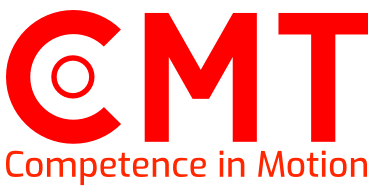
Efficient tools from NTN-SNR for mounting and dismounting rolling bearings
NTN-SNR offers a range of more than 130 hydraulic nuts for mounting and dismounting rolling bearings.
NTN-SNR has started to supply its distributors and customers with an extended range of hydraulic nuts, comprising more than 130 items. These hydraulic nuts are the most important part of the company's range of tools that ensure perfect mounting of medium to large bearings with full guarantee of long life. The improved technical characteristics of these hydraulic nuts, in terms of speed, safety and reliability in mounting bearings, make them the best performing premium quality products.
NTN-SNR has one of the widest ranges of hydraulic nuts on the market and, thanks to its production and logistics capabilities, is able to maintain a large stock of these products in order to meet any customer request immediately. This is another example of NTN-SNR's policy of expanding its product range, which underpins the company's development strategy. In this way, the company has established itself as a preferred partner for many industrial companies, guaranteeing them a long service life and low operating costs for their equipment.
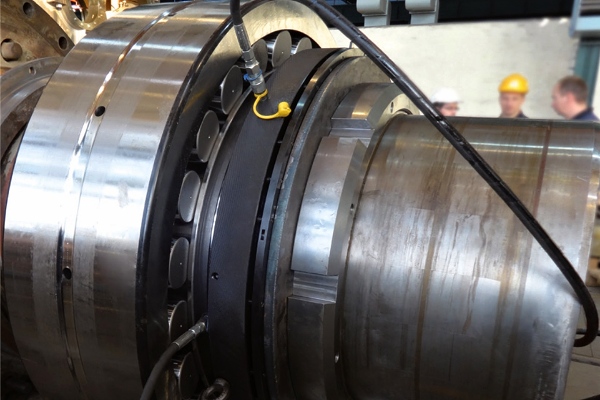
Innovations and improved technical features that contribute to the efficiency of equipment maintenance
NTN-SNR offers several technological innovations in its hydraulic nuts that provide a real competitive advantage in the mounting of large bearings, such as NTN-SNR spherical roller bearings with tapered bore ULTAGE series used in heavy machinery. These nuts facilitate and speed up the mounting of bearings while ensuring a high level of safety. They enable a significant increase in productivity and are characterised by maximum precision to ensure optimum system life.
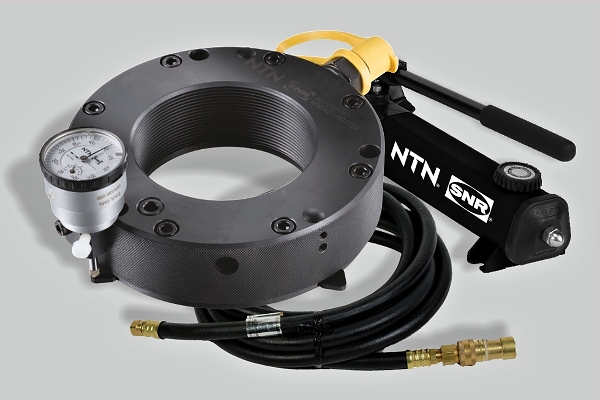
The four main innovations are:
- Automatic Piston Return, a patented mechanism that significantly speeds up the mounting and dismounting of bearings
- Anti-corrosion treatment, a special surface treatment that increases the life of hydraulic nuts
- Rolled and grooved surfaces, which ensure a better grip of the tool during labour-intensive assembly operations in various environmental conditions, especially in the presence of lubricants
- Safety system that relieves excessive oil pressure to prevent damage to the hydraulic nut or endangerment of assembly personnel
All the features of the NTN-SNR hydraulic nuts are based on the best examples from worldwide bearing installation practice and help to prevent premature bearing failure during operation. It should be noted that improper bearing installation can lead to total bearing failure. This can be very detrimental to large industrial companies when losses due to forced downtime are taken into account.
Wide range of accessories for mounting and dismounting bearings
Today, NTN-SNR offers the widest range of accessories for hydraulic nuts, including various pumps, high quality hoses, axial movement indicators and pressure gauges, quick couplers, hydraulic oils, clamping and coupling bushes. In addition to providing the necessary tools, NTN-SNR's Experts & Tools department offers technical support and advice on bearing maintenance at its technical centres in France, Morocco, Germany and, since last year, the UK. Finally, NTN-SNR offers training courses at its technical centres, as well as distance learning courses in the form of training videos demonstrating the best techniques for mounting and dismounting bearings in real conditions and on test benches.
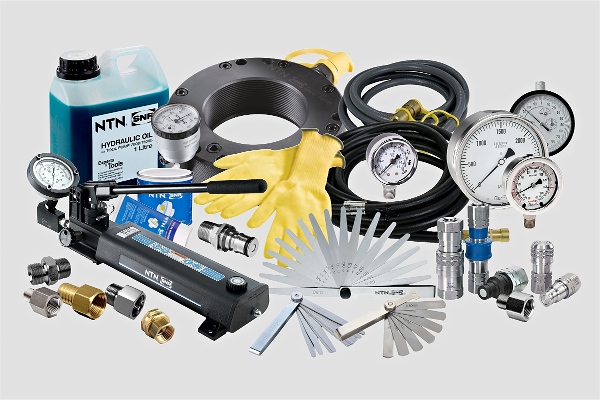
133 items in one of the most comprehensive ranges on the market:
- 84 items in metric dimensions, from the HMV 10 nut with a 50 mm bore diameter to the HMV 200 nut with a 1000 mm bore diameter
- 49 items in inch sizes, from the HMVC 10 nut with a bore diameter of 1.967 inches to the HMVC 190 nut with a bore diameter of 37.410 inches
Three different sets of hydraulic pressure pumps:
- Set for hydraulic nuts up to and including HMV 54 EBF with an oil volume of 0.3 litres and a generated pressure of up to 700 bar
- Set for hydraulic nuts up to and including HMV 92 EBF with an oil volume of 0.9 litres and a pressure of more than 700 bar.
- Kit for hydraulic nuts up to and including HMV 200 EBF with an oil volume of 2.5 litres and a pressure of more than 1,500 bar
Description of hydraulic nut
The NTN-SNR hydraulic nut type HMV...EBF is a tool that facilitates mounting and dismounting of rolling bearings with tapered bore. Installed bearings can be brought into the correct seating position on shafts safely and without excessive force using a hydraulic nut. The main application of the hydraulic nut is to mount bearings with 1:12 and 1:30 bore on tapered shaft seats and on cylindrical shaft seats with adapter or coupling sleeves.
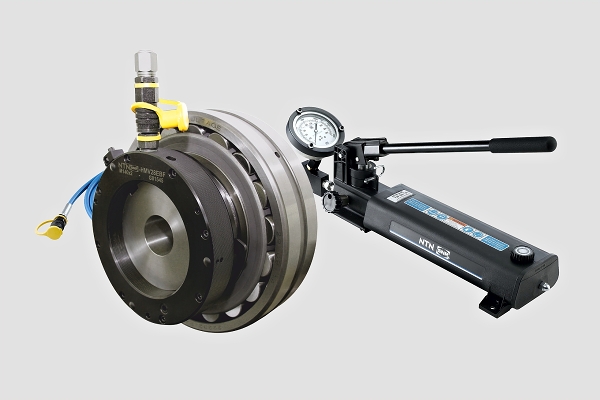
Structure of a hydraulic nut
A hydraulic nut consists essentially of an annular body and an annular piston. The nut body has a female thread in the bore, which is used to screw the nut onto the thread of a shaft or sleeve. The annular piston has two internal grooves with annular guide seals that seal the working chamber of the piston. The pressurised hydraulic oil in the nut is evenly distributed in the working chamber between the piston and the nut body, pushing the piston axially outwards.

- Hydraulic quick coupling for oil supply, with cover
- Hose connection O-ring seal
- External piston O-ring seal
- Internal piston O-ring
- Piston O-ring
- Housing nut
- Maximum stroke mark
- Pin with return spring
- Plug with ball valve
- Outer body with knurling
- Nut marking
- Plastic screw with M5 thread for fixing the motion indicator
- Motion indicator kit with extension and bracket
- Female thread in nut body
There is a through threaded hole on the knurled outer surface of the nut body and another hole on the front of the body which is sealed with a plug. These holes are used to supply oil to the piston working chamber via a special hydraulic hose connection. The threaded hole on the front of the nut is factory sealed with a tightly lapped plug with ball valve. A quick-release coupling for the oil supply hose is inserted into the other threaded hole on the outer knurled surface at the top. This connection can be fitted in either hole of the nut depending on practicality or available working space.
The ribbed knurling on the outer surface of the body of the hydraulic nut provides a secure grip when screwing onto the thread of the shaft or bushing. A rod-shaped handle, supplied with the hydraulic nut, is inserted into one of the blind holes on the outer surface of the nut body and is also used to facilitate screwing on the nut. Return springs on the circumference of the nut body ensure that the piston returns to its initial position when the oil pressure in the hydraulic system is released, facilitating the return of the oil to the pump tank. This is done automatically without the need to push the piston down by hand.
Hydraulic nuts from size HMV60EBF have additional tapped blind holes on the knurled outer surface of the body into which the supplied eye bolts can be screwed and which are used to safely transport large hydraulic nuts to the installation site using lifting equipment.
Hydraulic nut components
NTN-SNR hydraulic nuts consist of the following components:
- Plug with seal and ball valve
- Quick coupling for hydraulic hose
- Coupling O-ring seal
- Plastic screw for fixing the travel sensor
- Bracket for the travel sensor
- Handle for screwing on the nut
- DIN 580 eyebolt
- Piston O-ring kit
- Set of bolts with return springs
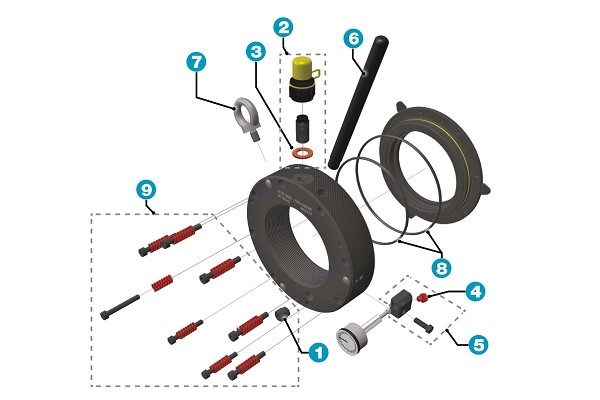
Operating principle of the hydraulic nut
Oil pressure in the internal working chamber of the nut body is generated by a hydraulic pump and pushes the ring piston axially out of the nut body. This piston movement pushes the bearing into its tapered seating position on the shaft or bushing. A displacement indicator with a circular hour scale is used to ensure that the bearing is positioned as accurately as possible in its seating position. When the hydraulic system of the nut is depressurised after the bearing has been installed, the piston automatically returns to its home position. At the same time, the oil automatically returns to the hydraulic pump tank.
Procedure for fitting bearings
To fit, the bearing is pushed onto the tapered seat as far as possible by hand. A hydraulic nut is then screwed onto the threaded part of the shaft or bushing until its ring piston makes contact with the bearing. When screwing on the hydraulic nut, ensure that the thread does not slip in order to avoid damaging the thread. Lubricate the thread area with special assembly paste or grease before screwing on the nut. To make it easier to position the large hydraulic nuts from size HMV90EBF before screwing them on, the start of the internal thread is marked on the outside of the nut body.
Bleeding the hydraulic system
The hydraulic system of the nut must be vented when the nut is first used or each time the hydraulic hose coupling is removed to prevent air bubbles in the oil. To bleed the hydraulic system, screw the nut over the full length of its threaded part onto the thread of the shaft or sleeve and connect the hose from the hydraulic pump to the appropriate hydraulic connection on the nut. Slightly loosen the ball valve plug located at the bottom of the front of the nut body by unscrewing it two or three turns. The hydraulic pump is then used to pump oil into the nut until oil comes out of the plug without air bubbles. After draining the hydraulic system, tighten the plug to a maximum torque of 45 Nm.
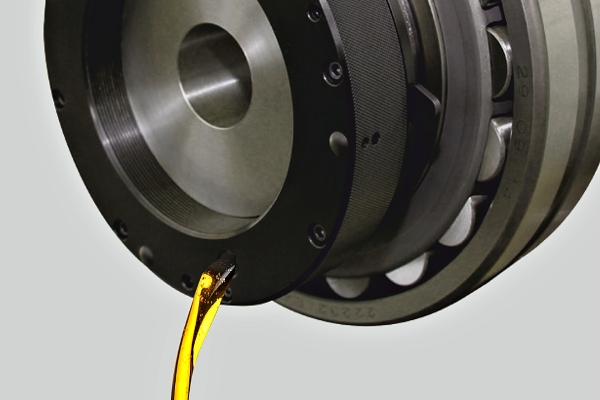
Preparing the hydraulic nut for use
The hydraulic nut is screwed onto the thread of the shaft or bushing until its ring piston is in contact with the roller bearing. The entire piston surface of the nut's ring piston must be in contact with the bearing. The piston itself must be in its home position and fully seated in the nut body. The overlap between the threads of the hydraulic nut and the threads of the shaft or bushing must be at least 85% to absorb the forces that occur when the bearing is moved into its seating position. The hose from the hydraulic pump is then connected to the appropriate hydraulic connection on the nut.
Some options for mounting and dismounting tapered roller bearings with a hydraulic nut
Mounting and dismounting of tapered roller bearings can be carried out in only three steps using the hydraulic nut.
Mounting the bearing
- The bearing is mounted with a hydraulic nut on a mounting sleeve on a threaded cylindrical shaft using the thread of the sleeve
- The bearing is supported on the retaining ring or shoulder of the shaft. Bearing mounted with a hydraulic nut on a shrink disc on a threaded cylindrical shaft
- The bearing is supported against the retaining ring or shoulder of the shaft. Mounting the bearing with a hydraulic nut on an adapter sleeve on a smooth cylindrical shaft using the sleeve thread
- Mounting the bearing with a hydraulic nut and hydraulic expansion method in a tapered fit on the shaft using the shaft thread
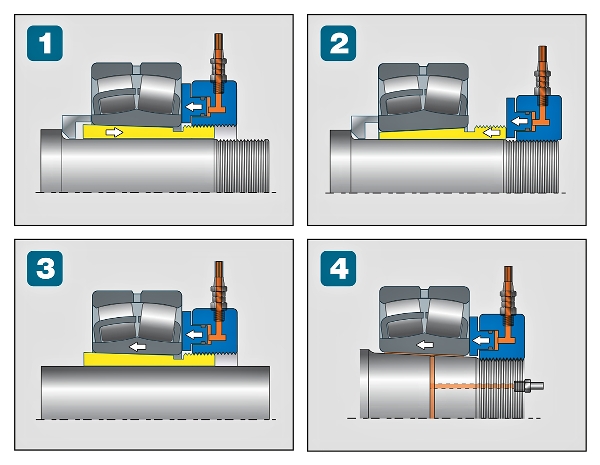
Bearing removal
- Remove the bearing from the shrink disc using a hydraulic nut over the thread of the shrink disc. The piston of the hydraulic nut will push the inner ring of the bearing
- Remove the bearing from the adapter sleeve using a hydraulic nut through the thread of the sleeve. The piston of the hydraulic nut applies pressure to the locknut mounted on the shaft thread
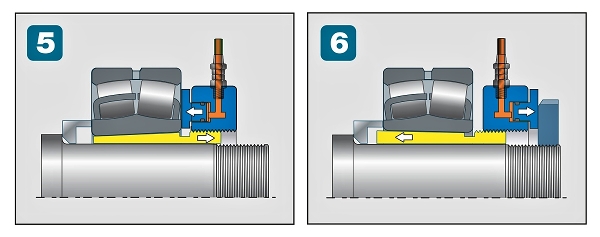
Determination of bearing position and axial displacement
A dial gauge can be used to determine the position and axial offset of the bearing during installation with the hydraulic nut. It is attached to the face of the nut using a special holder.
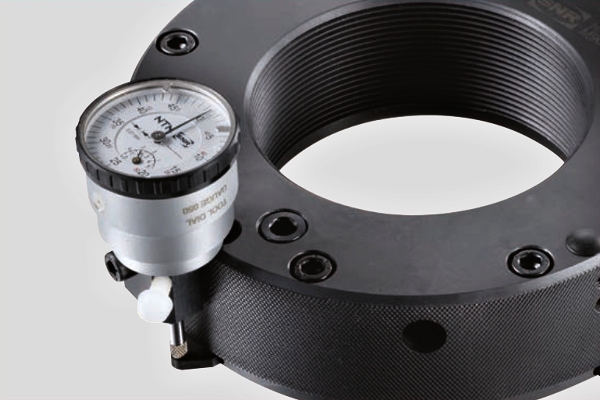
Mounting the dial indicator with holder
The holder for the dial gauge must not be fitted to the body of the hydraulic nut until the nut is fully tightened and the ring piston is in contact with the bearing or thrust piece. This is necessary to avoid possible injury when screwing on the nut and damage to the sensitive measuring device. The indicator holder is fitted to the knurled outer surface of the nut body using the guide pin and fixing screw in one of three possible positions opposite the corresponding projection on the ring piston. The displacement transducer is inserted into the bore of the holder until its measuring tip touches the projection on the annular piston.
In this position, the dial indicator is secured in the holder with a plastic screw to prevent slipping. The dial gauge is then set to the zero pointer position by turning the dial gauge bezel, the arrow on the bezel indicating the axial offset required for the bearing installation.
The axial offset depends on the internal clearance group in the bearing and the bearing size. A table showing the relationship between the clearance values of tapered bore bearings and their axial displacement during installation can be found in the Hydraulic Nuts manual.
Oil can now be pumped into the hydraulic nut using a hydraulic hand pump. This will cause the ring piston of the nut to move the bearing onto the sleeve or tapered seat on the shaft. Continue to inject oil until the required axial displacement of the bearing has been achieved. It is recommended that a final check of the bearing clearance in the mounted bearing is carried out using feeler gauges only after the hydraulic system of the nut has been depressurised.
The yellow circular mark on the piston of the hydraulic nut indicates that the maximum allowable piston stroke has been reached. When this mark coincides with the edge of the hydraulic nut housing, the piston must not be pulled further out of the hydraulic nut housing to avoid injury to maintenance personnel and damage to the hydraulic nut.
To remove the hydraulic nut after mounting or dismounting the bearing, open the oil pressure relief valve. When this is done, the ring piston of the hydraulic nut automatically returns to its starting position, forcing the oil out of the nut and back into the hydraulic pump. The hydraulic nut can now be removed and the mounted bearing secured in place with the lock nut and lock washer.
Three good reasons to use NTN-SNR hydraulic nuts:
- The most professional tool for applying the required force when mounting and dismounting bearings
- The most accurate and reliable bearing clearance adjustment
- Economical, simple and safe, reduces machine downtime
Detailed information about hydraulic nuts and their technical data, as well as recommendations for selecting rolling bearing nuts, can be found in the NTN-SNR Hydraulic Nut User Guide, which can be downloaded here.
If you are interested in high quality hydraulic nuts for mounting and dismounting rolling bearings and their accessories, as well as other high performance tools, we have everything you need.
We offer NTN-SNR products because we are convinced of their high quality and attractive price, and you can be sure that all products from this manufacturer fully meet the stated characteristics.
